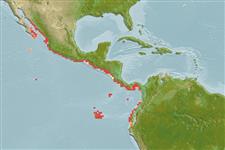>
Clupeiformes (Herrings) >
Engraulidae (Anchovies) > Engraulinae
Etymology: Anchoa: Italian ancioa = anchovy (Ref. 45335).
Eponymy: Charles Tate Regan (1878–1943) was a British ichthyologist. [...] (Ref. 128868), visit book page.
More on author: Regan.
Environment: milieu / climate zone / depth range / distribution range
Écologie
marin; profondeur 0 - 50 m (Ref. 189). Tropical; 28°N - 5°S, 111°W - 77°W (Ref. 189)
Eastern Pacific: southern half of Gulf of California to Ecuador, excluding the Galapagos Islands.
Taille / Poids / Âge
Maturity: Lm ? range ? - ? cm
Max length : 12.5 cm TL mâle / non sexé; (Ref. 96339); common length : 8.0 cm TL mâle / non sexé; (Ref. 55763)
Description synthétique
Clés d'identification | Morphologie | Morphométrie
Épines dorsales (Total) : 0; Épines anales: 0; Rayons mous anaux: 14 - 17. Body fairly elongate. Snout long, about equal to eye diameter; maxilla moderate, tip rather bluntly pointed, reaching onto inter-operculum, but not to edge of gill cover; gill cover canals of panamensis-type. Anal fin very short, its origin below or behind last dorsal fin ray base. A silver stripe along flank, about 3/4 eye diameter.
A schooling species found in coastal waters. Caught over sand or gravel in the Gulf of Nicoya but not in inner parts of the Gulf. May spawn over a protracted period in Gulf of Nicoya. The eggs are oval. TL = 1.25 SL.
Life cycle and mating behavior
Maturité | Reproduction | Frai | Œufs | Fécondité | Larves
May spawn over a protracted period in Gulf of Nicoya (Ref. 189). Spawn in school (Ref. 205).
Whitehead, P.J.P., G.J. Nelson and T. Wongratana, 1988. FAO Species Catalogue. Vol. 7. Clupeoid fishes of the world (Suborder Clupeoidei). An annotated and illustrated catalogue of the herrings, sardines, pilchards, sprats, shads, anchovies and wolf-herrings. FAO Fish. Synop. 125(7/2):305-579. Rome: FAO. (Ref. 189)
Statut dans la liste rouge de l'IUCN (Ref. 130435: Version 2024-1)
Menace pour l'homme
Harmless
Utilisations par l'homme
Pêcheries: pêcheries vivrières
Outils
Articles particuliers
Télécharger en XML
Sources Internet
Estimates based on models
Preferred temperature (Ref.
123201): 22.9 - 28.5, mean 26.6 °C (based on 46 cells).
Phylogenetic diversity index (Ref.
82804): PD
50 = 0.5000 [Uniqueness, from 0.5 = low to 2.0 = high].
Bayesian length-weight: a=0.00513 (0.00234 - 0.01125), b=3.14 (2.97 - 3.31), in cm total length, based on LWR estimates for this Genus-body shape (Ref.
93245).
Niveau trophique (Ref.
69278): 3.4 ±0.4 se; based on size and trophs of closest relatives
Résilience (Ref.
120179): Haut, temps minimum de doublement de population inférieur à 15 mois (Preliminary K or Fecundity.).
Fishing Vulnerability (Ref.
59153): Low vulnerability (10 of 100).
Nutrients (Ref.
124155): Calcium = 338 [181, 810] mg/100g; Iron = 2.18 [1.13, 4.02] mg/100g; Protein = 16.9 [14.6, 19.7] %; Omega3 = 0.303 [0.148, 0.631] g/100g; Selenium = 43.8 [18.8, 102.9] μg/100g; VitaminA = 30.5 [7.8, 99.9] μg/100g; Zinc = 1.85 [1.24, 2.75] mg/100g (wet weight);
